An array of ordinary garden mushrooms can be found, exhibiting white hues and domed tops, accompanied by brown or white gills. These mushrooms tend to grow in small clusters amidst the blades of grass. Examples of such common garden mushrooms include false parasol mushrooms (Chlorophyllum molybdites), field mushrooms (Agaricus campestris), puffball mushrooms, and white dunce caps (Conocybe apala).
In contrast, various mushrooms that thrive in lawns can be orange, tan, or brown in color. Fairy ring mushrooms, weeping widow mushrooms (Lacrymaria velutina), Agaricus placomyces, and scruffy twiglets (Tubaria furfuracea) exemplify the vibrant lawn mushrooms.
It is crucial to correctly identify mushroom species within your yard. This article serves as a rough guide to aid in recognizing common garden mushrooms. However, it is not an authoritative manual for identifying poisonous lawn mushrooms or offering advice on mushroom picking in your garden.
Keep in mind that some types of mushrooms found in gardens are highly toxic and can result in severe health consequences. Thus, it is essential to refrain from consuming any mushrooms from your garden without first identifying the species with complete certainty.
Within this article, you will discover beneficial tips and guidelines for identifying lawn mushrooms. Additionally, pictures of common garden mushrooms will assist you in identifying the fungi growing in your lawn.
Methods for Identifying Lawn Mushrooms
Distinguishing characteristics of typical lawn mushrooms include their color, cap shape, stem length, gill color beneath the cap, and aroma. Some mushrooms in your yard may have a spongy texture, while others possess gills or pores underneath the cap. By slicing the mushroom, the flesh’s color can also be observed.
Understanding Why Mushrooms Thrive in Lawns
The presence of mushrooms in your lawn indicates an abundance of organic matter within the soil. Lawn mushrooms are the fruiting bodies that feed on decaying organic material. Fungi flourish in lawns when ideal conditions are met, such as ample rainfall, high humidity, warm weather, and shaded environments.
Certain types of lawn mushrooms appear during late summer or early fall after a rainfall, forming white spongy growths that stand out amidst lush green grass. The appearance of these yard mushrooms indicates the decomposition of organic matter in the soil, enriching the nutrient content of your turfgrass.
Mushrooms can also emerge in lawns if there are old tree stumps beneath the surface. For instance, fairy ring mushrooms may grow in a circular pattern at the center of a lawn. These orange-brown mushrooms originate from decaying wood situated beneath the soil.
What Actions Should You Take Regarding Mushrooms in Your Lawn?
In most cases, you can leave the mushrooms be or mow over them with a lawn mower. However, if you have concerns regarding poisonous lawn mushrooms, it would be advisable to remove them and place them in a compost heap.
Varieties of Lawn Mushrooms (Accompanied by Images) – A Guide to Identification
Let us now delve into a closer examination of the diverse types of yard mushrooms that make appearances in lawns.
Fairy Ring Lawn Mushroom (Marasmius oreades)

Fairy ring lawn mushrooms grow in clusters, boasting slender elongated stems, brown or tan caps, and a propensity for feeding on decaying wood matter within the garden.
The fairy ring mushroom can be identified by its round, pale tan, or brownish-orange cap, long cylindrical stem, and widely spaced gills. A distinctive feature of fairy ring mushrooms is their tendency to grow in circular patterns within grassy areas. These edible lawn mushrooms thrive by consuming decaying wood material found within lawns.
Fairy ring lawn mushrooms typically reach heights of 1 to 2.5 inches (2 to 6 cm), with caps measuring between 0.5 to 5 inches (1 to 5 cm) in diameter. These commonly occurring yard mushrooms emerge during the summer months and persist through fall in lawns and meadows.
Identification of Lawn Mushrooms
Fairy ring lawn mushrooms possess identifiable tan to brown caps, often exhibiting a noticeable bump in the center. These mushrooms tend to grow in groups, forming arcs or rings.
False Parasol (Chlorophyllum molybdites)
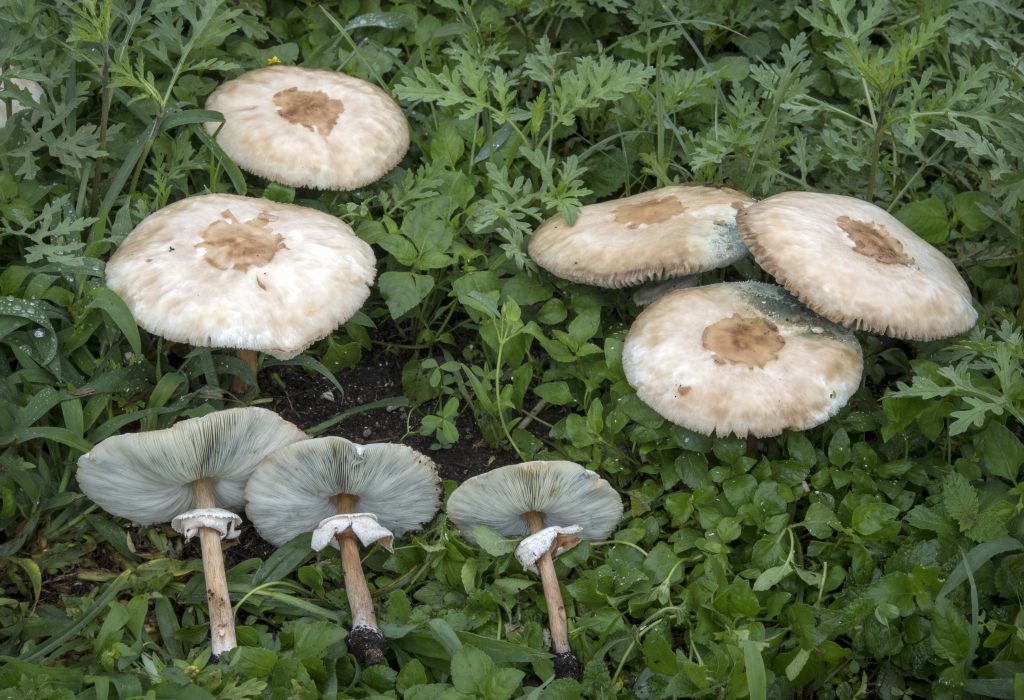
The false parasol is a lawn mushroom characterized by its white, flat cap with a brown circular center and a slender stem.
The false parasol is a white lawn mushroom with a large spherical cap that gradually flattens as it matures. As the white mushroom progresses, its cap develops a scaly texture, transitioning from a pinkish-brown to a brown hue at the center. These lawn mushrooms tend to grow in fairy rings throughout North America.
Typically, false parasol mushrooms grow between 3.14 to 7.8 inches (8 to 20 cm) tall, with their large whitish-brown caps measuring 4 to 8.6 inches (10 to 22 cm) in width. They possess white flesh and densely arranged white gills that gradually turn grayish-green.
Identification of Lawn Mushrooms
False parasol mushrooms can be identified by their large, round, relatively flat caps situated atop straight, erect white to brown stems.
Field Mushroom (Agaricus campestris)
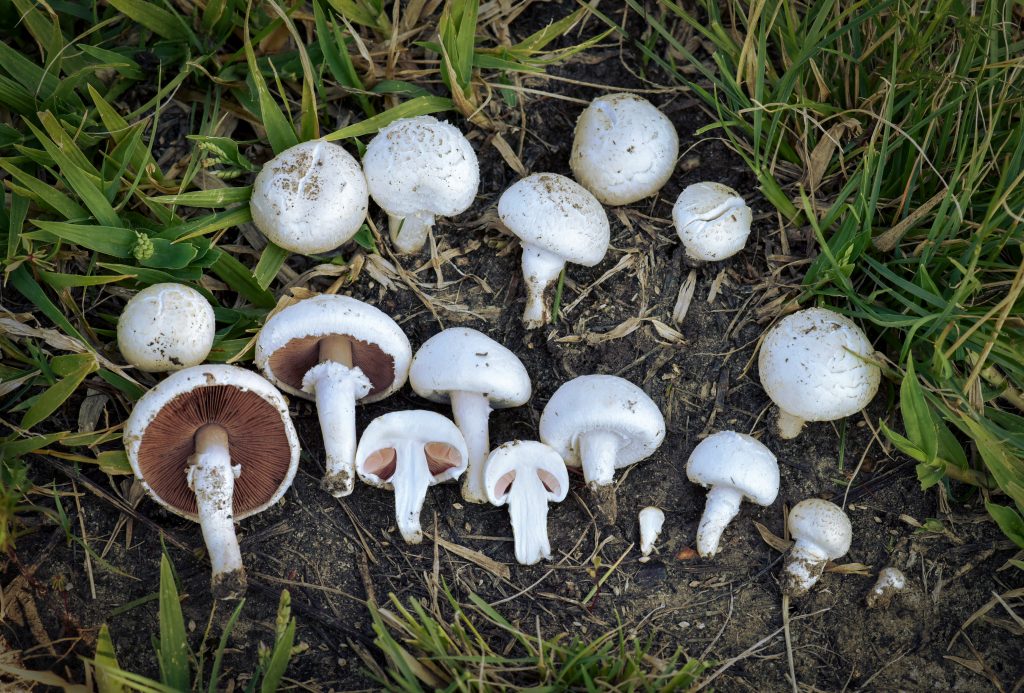
Field mushrooms can be recognized by their white caps and brownish gills, commonly found in grassy areas.
The field mushroom is a white edible mushroom that frequently emerges in lawns. Also referred to as the meadow mushroom, this fungus can be identified by its broadly convex white cap, dark pink or brown gills, and a thick white ringed stem. However, it is important to note that the field mushroom has poisonous look-alike counterparts.
Field mushrooms possess thick stems measuring between 1.18 to 4 inches (3 to 10 cm) in height, and their round white caps, almost flat in appearance, grow to widths of 1.18 to 4.7 inches (3 to 12 cm). Other notable features of these lawn mushrooms include their white, non-staining flesh and gills that initially appear pink and then transition to dark brown.
Identification of Lawn Mushrooms
The common field mushroom is identifiable by its white color, stocky growth, and tendency to thrive in grassy areas.
White Dunce Cap (Conocybe apala)
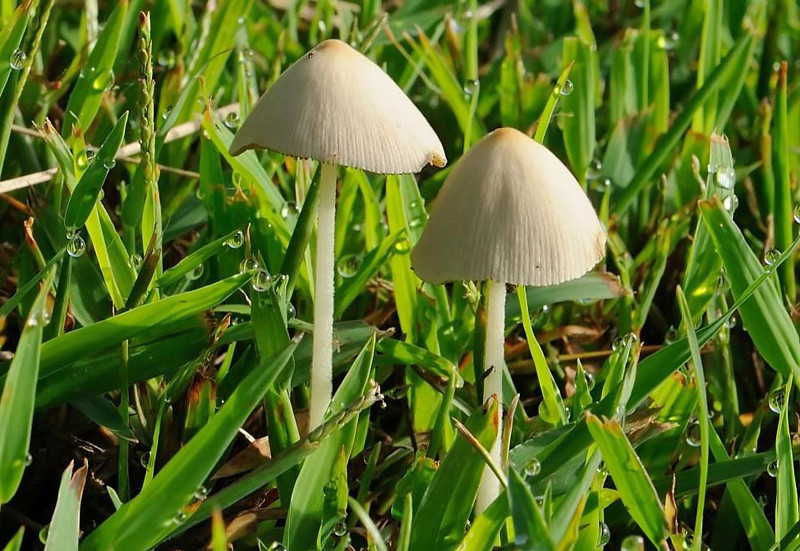
White dunce cap mushrooms possess thin stems with creamy white conical caps and can be found in grassy yards and lawns.
The white dunce cap is a slender, small white mushroom distinguished by its distinctly pointed pyramidal cap and rusty-brown gills. As the tiny mushroom grows, its conical white cap gradually opens up, resembling a parasol. Due to their small size, these white mushrooms can be challenging to spot amidst the grass.
White dunce caps typically grow between 2.7 to 4 inches (7 to 10 cm) in length, with pointed bell-shaped caps ranging from 0.6 to 1.18 inches (1.5 to 3 cm) in diameter. These pale cream-colored mushrooms commonly thrive in pastures, lawns, meadows, and other grassy areas with short grass. They often appear in lawns on warm sunny mornings but may disappear by the afternoon.
Identification of Lawn Mushrooms
White dunce cap mushrooms are easily recognizable due to their ultra-thin stems and conical white caps.
Weeping Widow Mushroom (Lacrymaria velutina)

The weeping widow lawn mushroom can exhibit a flat or bell-shaped pale brown cap and dark brown gills.
The weeping widow fungus is a large, pale brown mushroom featuring a broadly bell-shaped or flattened cap, dark brown gills, and a whitish-tan stem. This commonly encountered yard mushroom can grow singly in lawns or form extensive clusters. You may find these brown lawn mushrooms in pastures, lawns, or emerging from dead hardwood trees.
Impressively, weeping widow mushrooms possess long stems measuring between 1.5 to 4 inches (4 to 10 cm), with caps reaching widths of 1.18 to 3.1 inches (3 to 8 cm). At times, the stem can be as thick as it is long.
Identification of Lawn Mushrooms
The identifying features of the weeping widow mushroom include its large tan-colored bell-shaped cap, robust stem, dark brown gills, and white or brownish flesh.
Candolleomyces candolleanus
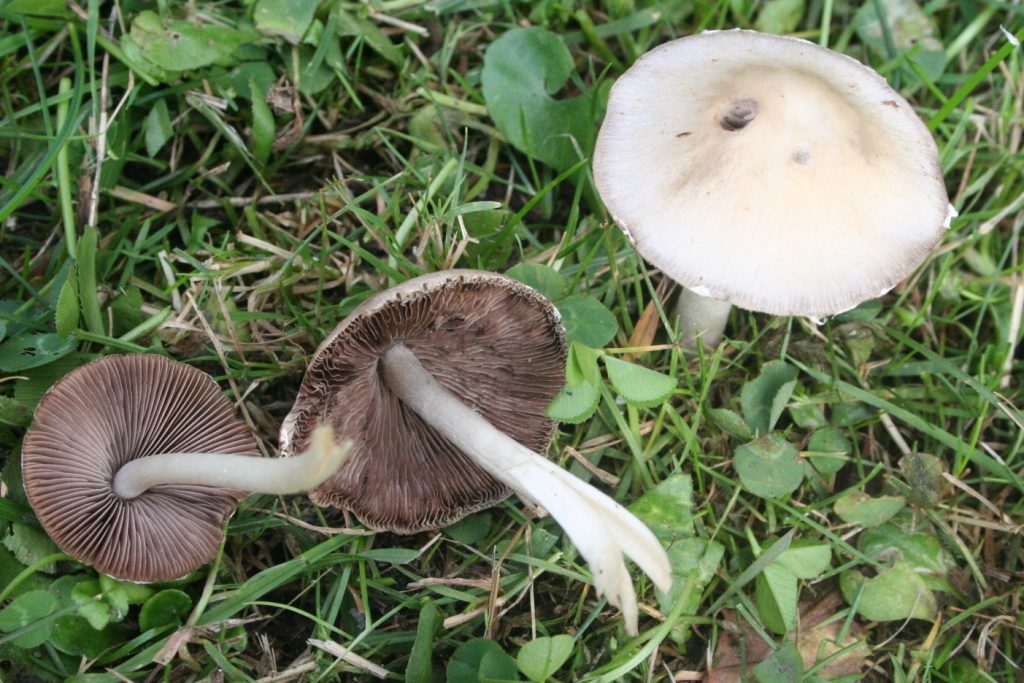
The Candolleomyces candolleanus mushroom is characterized by its skinny white stem and rounded white cap with brown gills.
The Candolleomyces candolleanus is a white mushroom possessing a large parasol-like cap, white stalk, and contrasting dark brown gills. This white lawn mushroom is distinguishable by its round white cap with asymmetrical and irregular edges. It is commonly found in lawns, pastures, and around tree stumps.
Candolleomyces candolleanus mushrooms typically grow to heights of 1.5 to 4 inches (4 to 10 cm), with their caps expanding up to 3 inches (7.5 cm) in width.
Identification of Lawn Mushrooms
Candolleomyces candolleanus is a prevalent lawn mushroom, recognizable by its round, flat white cap featuring a central bump, dark brown gills, and a slender white stem.
Agrocybe pediades
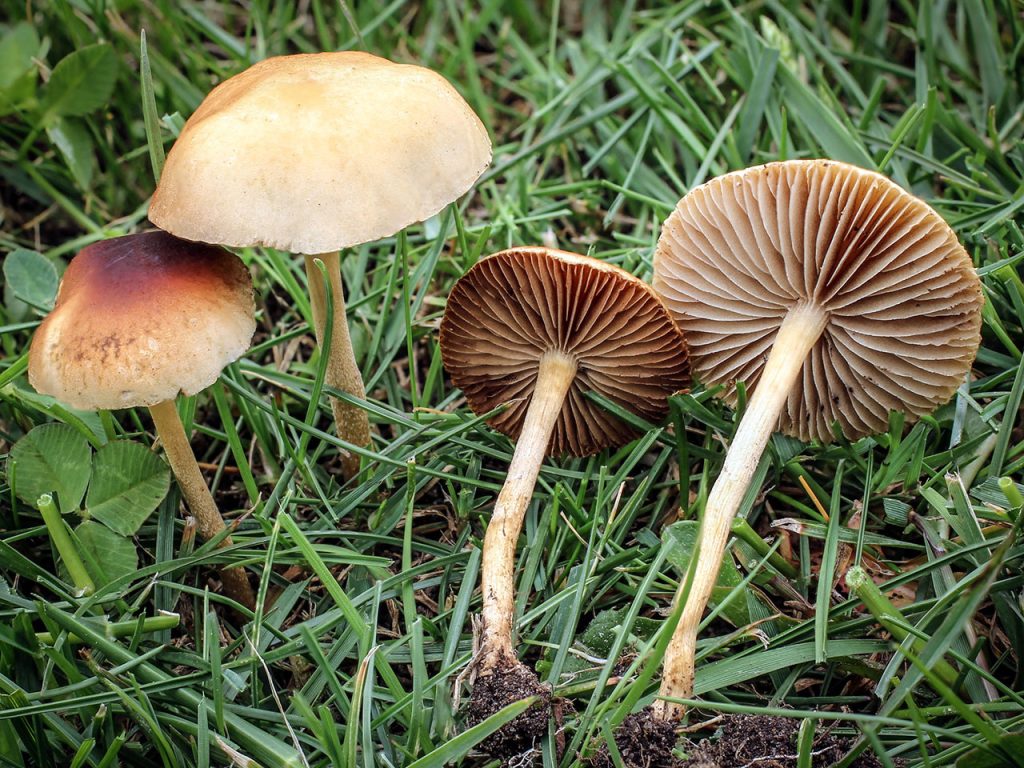
Agrocybe pediades is a typical lawn mushroom displaying a creamy white flat cap and a slim stem.
Agrocybe pediades is a commonly found lawn mushroom characterized by its conical whitish-tan cap, slender brown stem, and darker brown gills. A notable attribute of this small mushroom is its sticky cap. Furthermore, the creamy white cap becomes flattened as the mushroom matures. Although it is edible, the Agrocybe pediades has toxic look-alikes.
The slender light brown stalks of Agrocybe pediades grow to heights of 0.78 to 2 inches (2 to 5 cm), with pointed caps measuring 0.39 to 1.18 inches (1 to 3 cm) in width at the base. These mushrooms thrive in grassy areas, lawns, meadows, and even on compost heaps.
Identification of Lawn Mushrooms
The identifying features of Agrocybe pediades include its creamy white to tan color, smooth and tacky conical cap, and slender straight stem.
Agaricus placomyces
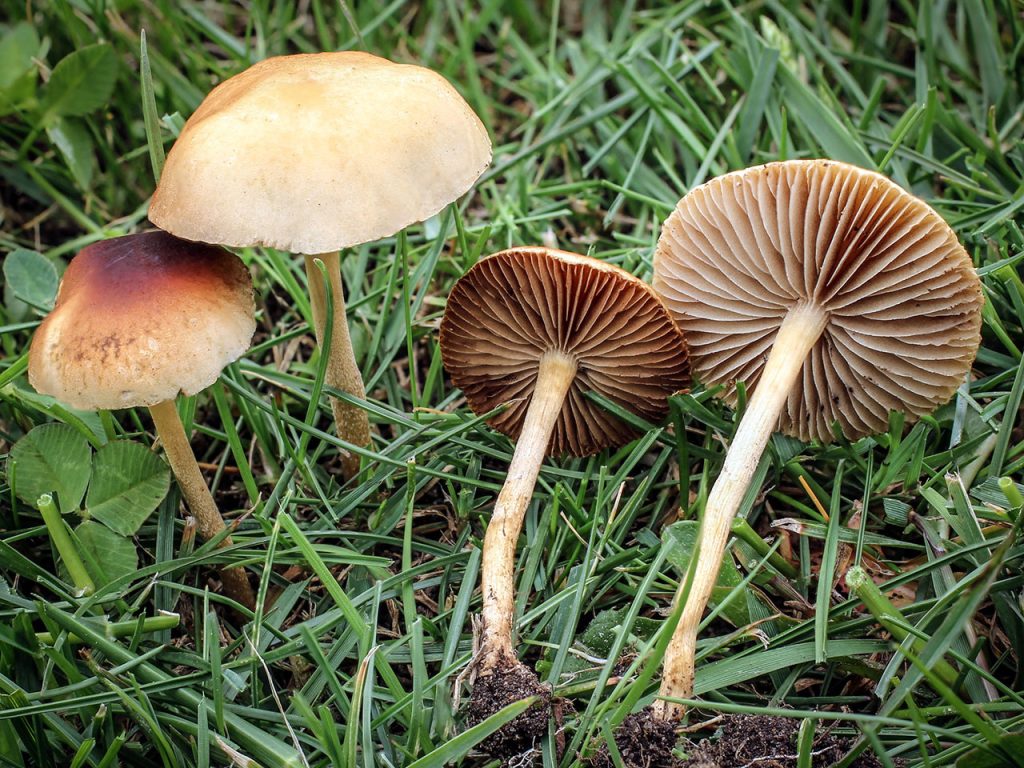
The Agaricus placomyces mushroom grows in lawns under trees and features a pale flat cap with a darker center.
Agaricus placomyces mushrooms are characterized by their large whitish-tan to pale brown fruiting bodies, flat caps with white scales, smooth white stems, and brownish scales and fibers on the cap. These mushrooms possess ragged margins, white flesh, and a tall growth habit.
Agaricus placomyces mushrooms grow to heights of 2.3 to 6 inches (6 to 15 cm), with their large, round caps often fraying at the edges and reaching widths of up to 6 inches (15 cm). These large tan mushrooms can be found in lawns under trees during the summer and fall seasons.
Identification of Lawn Mushrooms
Agaricus placomyces mushrooms can be identified by their broadly convex, round light brown caps with dark brown centers and slightly upward growth at the cap margins.
Parasol Mushroom (Macrolepiota procera)

The parasol mushroom can be identified by its bell-shaped white scaly cap, which flattens and turns brown as it matures.
The parasol mushroom is a white lawn mushroom with a distinctively rounded bell-shaped cap adorned with scaly growths. This large white mushroom initially emerges with a white, egg-shaped cap, gradually transitioning to a bell shape, and finally flattening out to a chocolate brown color. The underside of the scaly white cap features white gills, sometimes tinged with pink.
Parasol mushrooms grow to heights of 12 to 15 inches (30 to 40 cm), boasting a large chocolate-brown cap. These edible lawn mushrooms are highly prized for their size, taste, and versatility in culinary applications.
Identification of Lawn Mushrooms
The distinguishing features of the parasol mushroom include its dome-like white cap covered in brownish scales, situated atop a tall stem.
Scruffy Twiglet Mushroom (Tubaria furfuracea)
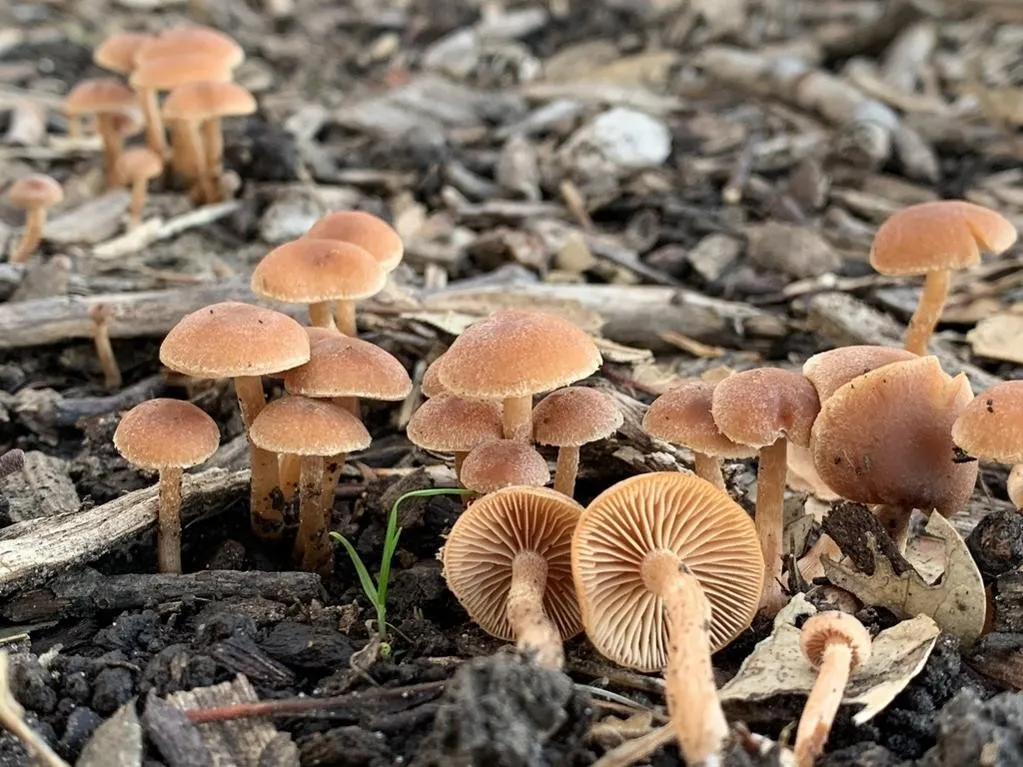
The small scruffy twiglet mushroom exhibits an orange-brown coloration and possesses a slender stem.
The scruffy twiglet mushroom is a small orange-brown fungus featuring a flat to convex cap, whitish patterns, a slender stalk, and tawny brown gills. This common lawn mushroom can occasionally grow in extensive clusters in shaded areas of lawns beneath hardwood trees.
Tawny-brown scruffy twiglet mushrooms grow to heights of 0.39 to 2 inches (1 to 5 cm), with their somewhat rounded caps reaching widths of up to 1.57 inches (4 cm).
Identification of Lawn Mushrooms
The orangish-brown scruffy twiglet mushroom has a small, slightly rounded cap and emits a mild odor.
Common Morel (Morchella esculenta)
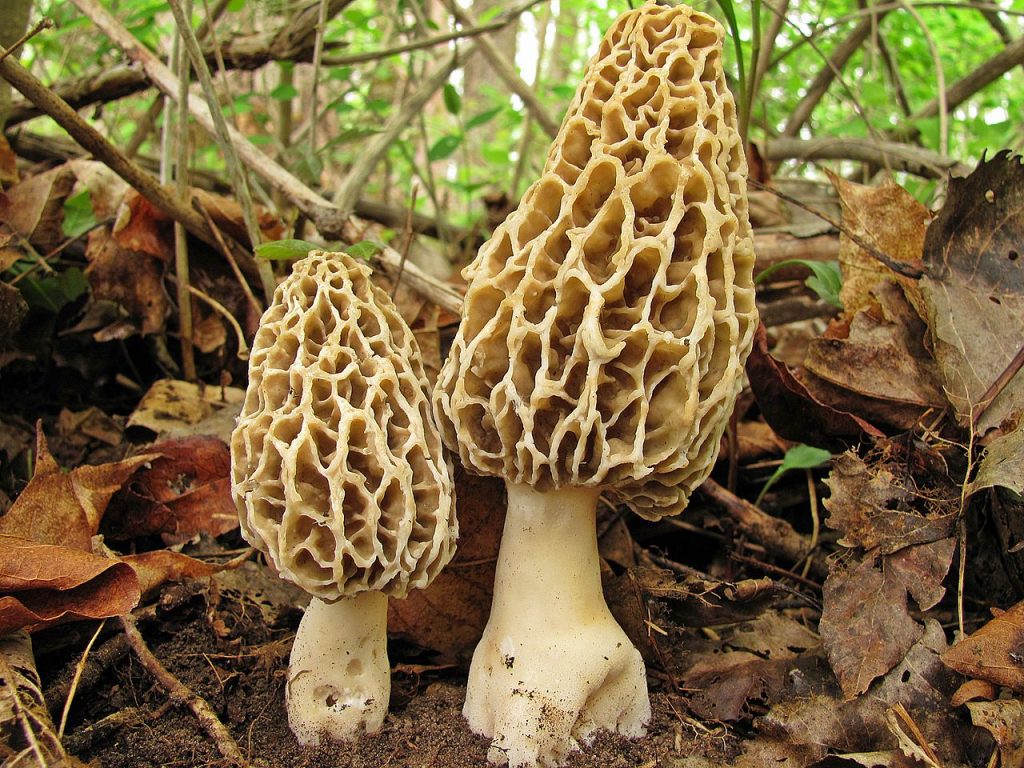
The common morel mushroom is recognized by its unique patterned cap, which can be pale or dark brown, and its relatively short, stout stem.
The common morel is a pale, brownish-cream to darker grayish-brown mushroom sporting a distinctively spongy appearance. This easily recognizable edible mushroom features an irregular, egg-shaped cap attached to a short, stout stem. These wild brown mushrooms are typically found in lawns, pastures, and meadows.
The oval, bumpy, sponge-like cap of the common morel measures 0.78 to 2.7 inches (2 to 7 cm) in diameter, while its stem ranges from 0.78 to 3.5 inches (2 to 9 cm) in length.
Identification of Lawn Mushrooms
The identifying characteristic of the common morel lies in its unique honeycomb-like appearance, characterized by irregular ridges and holes.
Destroying Angel Mushroom (Amanita bisporigera)
The poisonous destroying angel mushroom possesses a white, rounded cap that flattens as it matures, accompanied by a skirt-like ring around its stem.
The destroying angel is a poisonous white lawn mushroom displaying a pure white cap, gills, flesh, and stem. The cap initially emerges in an egg-like shape before gradually flattening out. Although the ivory color of this large mushroom may appear attractive, it is crucial to note that it can be deadly if consumed due to its high toxin content.
Destroying angel mushrooms grow to heights of 3 to 8 inches (7.5 to 20 cm), with caps
spanning 2 to 4.5 inches (5 to 12 cm) in width. Foraging for mushrooms can be risky since the destroying angel is easily mistaken for edible meadow mushrooms, button mushrooms, or puffball mushrooms.
Identification of Lawn Mushrooms
The destroying angel mushroom is a poisonous white fungus featuring an egg-shaped or flattened cap and a veil-like ring encircling its stem, serving as a warning sign.
Shaggy Ink Cap (Coprinus comatus)
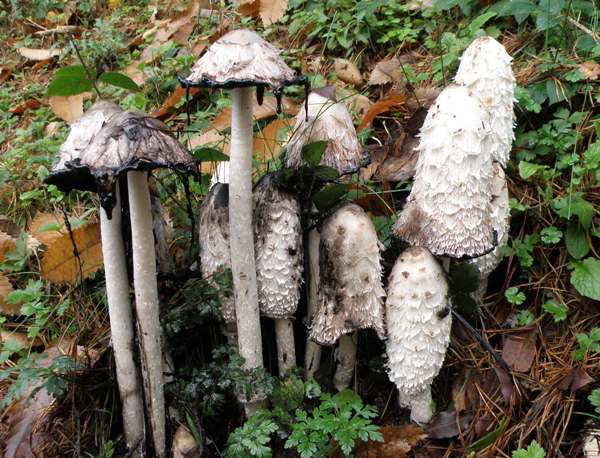
The shaggy ink cap mushroom grows in clusters in lawns and exhibits a whitish conical cap with scaly black edges as it matures.
The shaggy ink cap is a whitish mushroom showcasing a conical or bell-shaped shaggy cap that can unexpectedly emerge in lawns. The distinct feature of this lawn mushroom is the black ink-like coloration that appears on older specimens. These whitish-black mushrooms tend to grow in lines, clusters, or fairy rings on lawns.
Shaggy ink cap mushroom stems reach heights of 2 to 8 inches (5 to 20 cm), while the conical scaly cap can add another 6 inches (15 cm) in height.
Identification of Lawn Mushrooms
The easily identifiable characteristic of the shaggy ink cap is its white conical cap that transforms into a black, scaly appearance as it matures.
Puffball Mushrooms in the Lawn
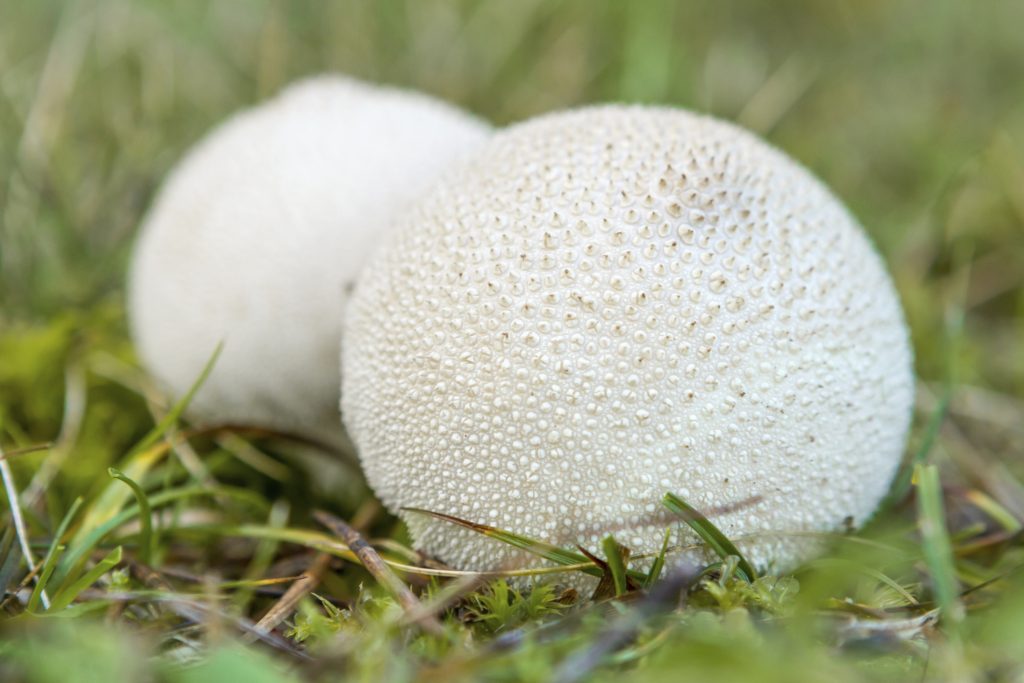
Puffball mushrooms encompass a variety of fungi exhibiting various sizes, colors, and textures, with some lacking a visible stem.
Puffball mushrooms are common white lawn mushrooms characterized by their spherical fruiting bodies. Unlike most mushrooms that grow in yards, puffballs lack an open cap, and some may not possess visible stems. Instead, these white or pale brown fungal growths resemble clusters of small eggs or white balls in lawns.
The term “puffballs” encompasses a wide variety of woodland and lawn mushrooms featuring enclosed oval or round caps.
Basket Stinkhorn Mushroom (Clathrus ruber)
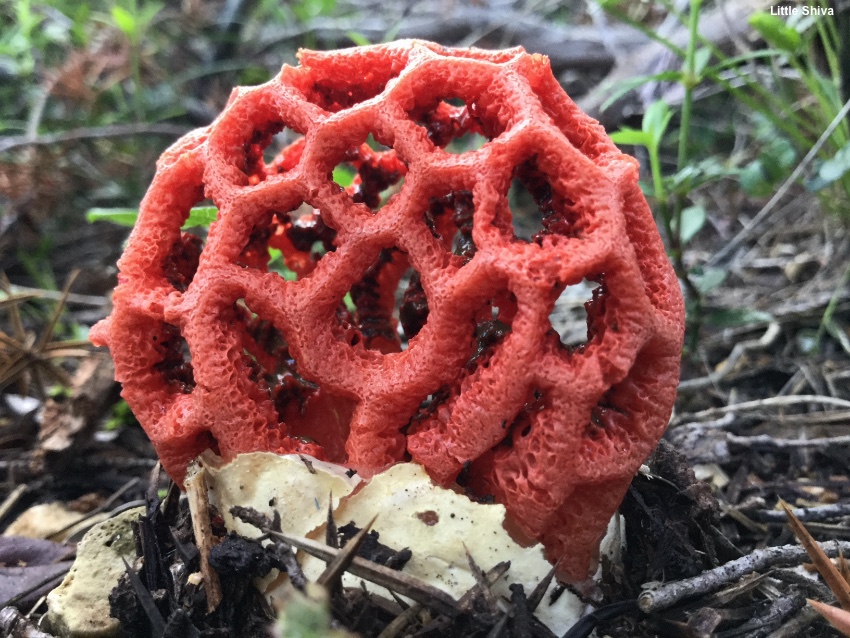
The unusual red basket stinkhorn mushroom can be found in lawns or yards and showcases a spherical, latticed appearance.
The basket stinkhorn mushroom stands out as one of the most peculiar lawn mushrooms due to its growth pattern, featuring a network-like arrangement of red, spongy “arms.” This distinctive red mushroom resembles a ball-shaped pinkish-red basket covered in black spores at the center. These red lawn mushrooms can reach diameters of up to 2.4 inches (6 cm).
Identification of Lawn Mushrooms
The easily identifiable reddish basket stinkhorn consists of a mesh of arms, creating an oval lattice-like structure.
Pinwheel Mushroom (Marasmius rotula)

The delicate pinwheel mushroom possesses a thin, dark stem with a small white cap and widely-spaced gills.
The pinwheel mushroom is a dainty species recognized by its thin white round cap perched atop wiry brown stems. Depending on the growing conditions, these small mushrooms can exhibit brownish patches on white caps or dark brown caps. The widely-spaced gills mirror the color of the cap.
Pinwheel mushrooms typically grow between 0.5 to 3.1 inches (1.2 to 8 cm) in height, with their tiny whitish caps measuring 0.1 to 0.8 inches (0.3 to 2 cm) in diameter.
Identification of Lawn Mushrooms
The pinwheel mushroom, a type of small fungi commonly found in lawns, can be identified by its thin brown stem supporting a convex-shaped whitish cap.
White Dapperling Lawn Mushroom (Leucoagaricus leucothites)
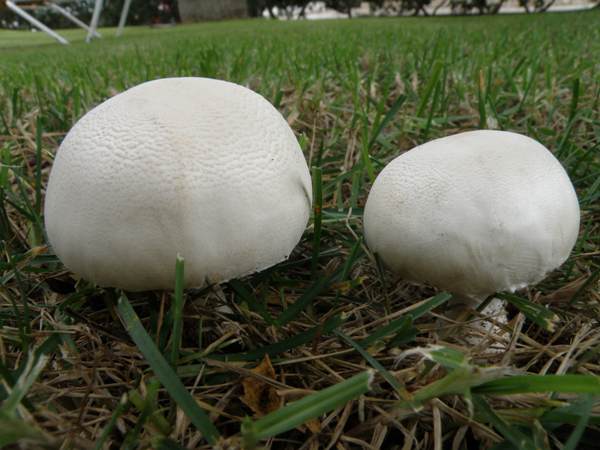
The white dapperling lawn mushroom possesses a rounded cap that becomes flat as it matures.
Also known as the white Agaricus mushroom, this large pure white mushroom frequently appears in lawns, parks, and grassy areas. It can be recognized by its egg-shaped cap that opens up and eventually flattens, often exhibiting a central bump. However, caution is advised as this species has several poisonous look-alikes.
White dapperling mushrooms grow to heights of 2 to 4.7 inches (5 to 12 cm), boasting large rounded convex caps measuring 1.5 to 6 inches (4 to 15 cm) in width.
Identification of Lawn Mushrooms
The white dapperling mushroom is easily identified by its whitish cap, pure white gills, and white stem with a veil ring three-quarters up the stem.